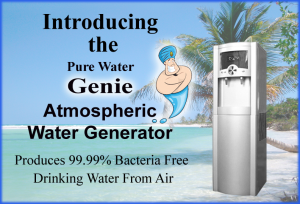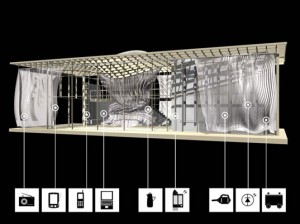While water covers 73% of the earth’s surface, clean water is, in many parts of the world, a scarce and expensive resource, and is increasingly becoming more scarce and more expensive. It is common in the eastern and central parts of the US, however, even here we experience water shortages. Frakking, coal processing, cooling nuclear power plants, and other industrial processes require clean water, and produce dirty water, and water shortages are predicted in 36 states over the next 5 years.
Yet water is in the air. It’s easier to pull water out of a river or a stream, or even out of the ground, where it exists in the liquid state, than to condense water vapor out of the air, but this is about to change. And water vapor in the air is cleaner than water on the ground.
 The Vapour Inc Pure Water Genie ™ condenses water out of the air, and uses about 1 kwh per gallon, depending on humidity and air temperature. The units come in various sizes for personal or office applications to embassy scale sizes.
The Vapour Inc Pure Water Genie ™ condenses water out of the air, and uses about 1 kwh per gallon, depending on humidity and air temperature. The units come in various sizes for personal or office applications to embassy scale sizes.
My friends at Vapour Inc, call it the “Pure Water Genie.” I would call it a “Cloud Machine,” or a “Box of Rain.”
Consider the American Embassy in Damascus, or Tehran, or a military base in Afghanistan. The Vapour Pure Water Genie is a source of pure water in hostile territory. If the American Embassy in Tehran had it’s own discrete and independent water supply back in 1979, our military could have been better able to secure the site. If remote military bases in various operating theaters have their own discrete and independent water supplies, then we don’t have to allocate resources to move water in hostile territory; our logistics positions are stronger. If we can pull water out of thick air, we don’t need to burn fuel or risk lives transporting it. If it’s coupled with a solar energy system then our embassies we don’t need fuel for generators in countries like Egypt, Iraq, Syria, Pakistan, Russia and China, which are either unstable, potentially hostile, have limited supplies of clean water, an unstable energy supply and distribution system.
The Vapour Genie uses electricity to pull water out of air without plastic and fuel used to bottle and transport bottled water. The water is chemical-free, with purity second only to distillation. This is unmatched by bottled water, and in some cases tap water. The six-stage filtration includes: Sediment, Sterilize, Carbon Block, TCR, UF, UV. As fuel prices go up, so will the cost of transporting bottled water. As the costs of “disposing” and recycling plastics increases, so will the cost of bottled water. But while fuel prices and plastic recycling costs will go up, solar energy systems will be stable or drop due to advances in engineering. (See my post from Dec. 17, 2011, “Moore’s Law Applied to Solar Power,” here.)
The Pure Water Genies perform optimally in 70% to 80% humidity and temperatures between 75 F and 84 F (24 C and 29 C). We can’t control ambient humidity, but we can control temperature. In Kabul, Afghanistan, for example, in a controlled room with 78 F, the humidity will range from 33% in August to 77% in February. The Water Genie 5000 will produce 600 liters per day in August and 4650 liters per day in February.
These could replace water coolers in offices across the United States – and according to John at Vapour Inc., there are 12 million today. And these could provide a secure water supply for our embassies and for service personnel on missions around the world.





